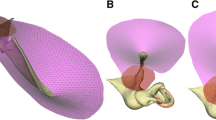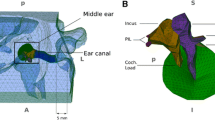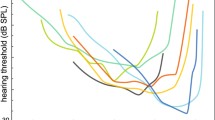Abstract
A one-dimensional computer model of the peripheral ear was explored using pure-tone inputs. This model was adopted after frequency-domain modeling showed that the differences between one- and two-dimensional models were small. The inner ear representation was the classical mass-spring-damper transmission line. In the time-domain simulations, this classical model was modified to have adjacent elements of the cochlear partition model lightly coupled to each other via springs.
Simulation of the entire peripheral ear demonstrated that the parameters used in Neely’s (1981), Allen’s (1977) and our model were fairly well chosen. All three representations yielded cochlear input impedances that accurate approximated Lynch et al.’s (1982) results at higher frequencies, and they yielded sound pressure levels at the partition that approximated Nedzelnitsky’s (1980) measurements at low frequencies. In addition, very low values of cochlear partition damping resulted in highly peaked displacement curves that were approximately correct in amplitude (near 1 A at 0 dB SPL for 1 kHz).
The effect of moderate longitudinal stiffness coupling was to broaden significantly the width of the resonant peak in the lightly damped case, at the cost of only slightly reducing the peak’s magnitude. Proper values of this longitudinal coupling resulted in tuning-curve shapes and values of Q10 that were quite realistic.
Access this chapter
Tax calculation will be finalised at checkout
Purchases are for personal use only
Preview
Unable to display preview. Download preview PDF.
Similar content being viewed by others
References
Allen, J. B., “Two-dimensional cochlear fluid model: New resulta,” J. Acouat. Soc. Am. 61, pp. 110–119, 1977.
Allen, J. B., “Cochlear micromechanica — A phyalcal model of tranaduction,” J. Acoust. Soc. Am. 68, pp. 1660–1670, 1980.
Allen, J. B. and Sondhi, M. N., “Cochlear macromechanics: Time domain solutions,” J. Acoust. Soc. Am. 66, pp. 123–132, 1979.
Geialer, C. D., “Mathematical modela of the mechanica of the inner ear,” in Handbook of Sensory Physiology, Auditory System. Ed’s. W. D. Keidel and W. D. Neff, Springer-Verlag, New York, pp. 391–415, 1976.
Geisler, C. D. and Sinex, D. G., “Comparison of click responses of primary auditory fibers with minimum-phase predictions,” J. Acoust. Soc. Am. 73. pp. 1671–1675, 1983.
Guinan, J. J., Jr. and Peake, W. T., “Middle-ear characteristics of anesthetized cats,” J. Acoust. Soc. Am. 41, pp. 1237–1261, 1967.
Hall, J. L., Two-tone distortion products in a nonlinear model of the basilar membrane,” J. Acoust. Soc. Am. 56, pp. 1818–1828, 1974.
Hubbard, A. E. and Geisler, C. D., “A hybrid-computer model of the cochlear partition,” J. Acoust. Soc. Am. 51, pp. 1895–1903, 1972.
Khanna, S. M. and Leonard, D. G., “Basilar membrane tuning in the cat cochlea,” Science 215. pp. 305–306, 1982.
Liberman, M. C., “The cochlear frequency map for the cat: Labeling auditory-nerve fibers of known characteristic frequency,” J. Acoust. Soc. Am. 72, pp. 1441–1449, 1982.
Lynch, T. J., III, Nedzelnitsky, V., and Peake, W. T., “Input impedance of the cochlea in cat,” J. Acoust. Soc. Am. 72, 108–130, 1982.
Nedzelnitsky, V., “Sound pressures in the baaal turn of the cat cochlea,” J. Acouat. Soc. Am. 68, pp. 1676–1689, 1980.
Neely, S. T., “Finite difference solution of a two-dimensional mathematical model of the cochlea,” J. Acoust. Soc. Am. 69, pp. 1386–1393, 1981.
Neely, S. T. and Kim, D. O., “An active cochlear model shows sharp tuning and high sensitivity” Hearing Res. 9, pp. 123–130, 1983.
Rhode, W. R., “Some observations on cochlear mechanics’” J. Acouat. Soc. Am. 64, pp. 158–176, 1978.
Sellick, P. M., Patuzzi, R. and Johnatone, B. M., “Meaaurement of baailar membrane motion in the guinea pig uaing the Moasbauer technique,” J. Acouat. Soc. Am. 72, pp. 131–141, 1982.
Steele, C. R. and Taber, L. A., “Compariaon of WKB calculations and experimental modela results for three-dimensional cochlear models,” J. Acoust. Soc. Am. 65, pp. 1007–1018, 1979.
Author information
Authors and Affiliations
Editor information
Editors and Affiliations
Rights and permissions
Copyright information
© 1986 Springer-Verlag Berlin Heidelberg
About this paper
Cite this paper
Wickesberg, R.E., Geisler, C.D. (1986). Longitudinal Stiffness Coupling in a 1-Dimensional Model of the Peripheral Ear. In: Allen, J.B., Hall, J.L., Hubbard, A.E., Neely, S.T., Tubis, A. (eds) Peripheral Auditory Mechanisms. Lecture Notes in Biomathematics, vol 64. Springer, Berlin, Heidelberg. https://doi.org/10.1007/978-3-642-50038-1_15
Download citation
DOI: https://doi.org/10.1007/978-3-642-50038-1_15
Publisher Name: Springer, Berlin, Heidelberg
Print ISBN: 978-3-540-16095-3
Online ISBN: 978-3-642-50038-1
eBook Packages: Springer Book Archive




